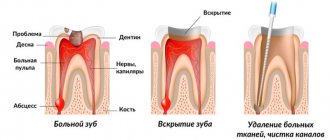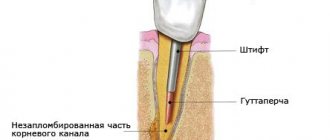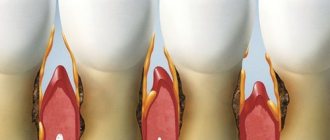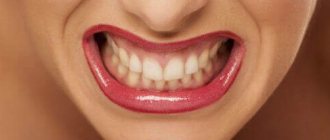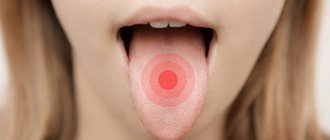28.10.2019
After nerve removal and canal cleaning, teeth may hurt when pressed for both natural and pathological reasons. Under the influence of whatever factors such pain occurs, it is called post-filling pain.
If the symptom bothers you for no more than 7 days and becomes weaker every day, there is nothing to worry about. Most likely, it is a completely natural physiological reaction of the body to surgical intervention. If the pain persists for a long time and is severe, you should contact your dentist for re-treatment.
Why does a tooth hurt after root canal cleaning?
Cleaning tooth canals
Pain after canal cleaning occurs in 98% of cases. The causes of negative sensations are the impact on soft tissues in the oral cavity and damage to the gums for medical purposes. Main reasons:
- Delayed visit to the doctor.
- Serious inflammatory processes in the oral cavity (after successful cleaning, the inflamed periodontium remains, which causes pain).
- Individual intolerance of the body. Itching adds to the pain, swelling of the gums and hyperemia appear. Additionally, there are symptoms of allergic rhinitis (reactions to medications or materials used).
- A splinter remains in the tooth; to get rid of the pain, the reading procedure is repeated.
- There was a poor-quality placement of the filling - sometimes during the process, perforation of the root occurs or the filling composition fills the space and extends to the top of the tooth.
The main manifestation of the problem is unpleasant, uncomfortable sensations when pressing on the gums. Pain occurs when a person bites into hard food.
Features of nerve removal
Experienced doctors perform depulpation only as a last resort. But sometimes it is impossible to do without it. What is the procedure? First, an x-ray is taken, from which the dentist draws conclusions about the condition of the pulp (nerve tissue), areas around the root and gets an idea of how deep the inflammation has spread. The specialist assesses the length of the nerve and the features of its location, then gets to work and acts in several stages:
- anesthesia: local anesthesia to relieve the patient of inevitable discomfort. Modern drugs make it possible to carry out all manipulations absolutely painlessly,
- caries removal: the dentist drills out the affected areas of enamel and dentin using a drill,
- nerve removal: using a special tool called a pulp extractor, which is screwed into the canal, the dentist removes the neurovascular bundle in several stages,
- expansion and cleaning of the canals: carried out so that the doctor can efficiently clean the canals from remnants of nervous tissue and prepare them for filling. The channels are expanded with thin burs, which help to level and smooth the inner surface of the walls,
- filling: a material specially designed for filling (for example, gutta-percha) is injected to the entire depth of the root. The consistency of this substance allows you to fill the cavity entirely so that there are no empty areas left there. The upper part is covered with composite material. In some cases, a large inlay is placed or a crown is installed over the filling.
A tooth left without a nerve is called “dead.” It becomes insensitive to irritants, and enamel mineralization stops. It loses its whiteness and acquires a dark shade. To restore an aesthetic appearance, the dentist may suggest performing intra-canal whitening, installing a veneer or an aesthetic ceramic (or metal-ceramic) crown.
In what cases is this normal?
Rinsing with a decoction of chamomile or sage will help relieve the condition.
Pain is considered normal if it does not intensify and gradually decreases. Unpleasant sensations can persist for a long time – up to 1 month. If the pain intensifies or becomes sharp 2-4 days after the procedure, it is necessary to repeat the cleansing or have the dental canals filled.
A gradually decreasing intensity of pain is a normal reaction of the body to the intervention in the gum tissue. Rinsing will help eliminate discomfort in the area of the treated tooth. It should be based on decoctions of medicinal herbs such as chamomile or sage.
Important! Increasing negative feelings and ignoring the problem can lead to tooth extraction.
Types of pain and what they mean
There are different types of pain. Experts highlight the following:
| Variety | Meaning |
| When biting, pressing, tapping or pressing | An inflammatory process takes place. Healing should begin within 1-2 days. Intensification of negative processes when biting indicates the need for repeated cleaning or a medical error. |
| Acute pain | If the tooth hurts severely and the pain persists for more than 3 days and does not subside, then this symptom may indicate infection, the remainder of the tooth, or an individual characteristic of the body. Seeing a doctor in this case is necessary. |
| It's a dull pain | If the tooth aches, this indicates inflammatory processes, a slow process of tissue restoration, or the need to repeat the canal cleaning procedure. |
| Throbbing sensation | The tissue healing process is going on; a piece of tooth or instrument remains in the canal. |
Pain under the crown when pressing
If after dentures there is pain under the crown of a dead tooth when biting, there may be several reasons. The tooth begins to hurt due to mechanical stress in the near future after prosthetics in the following situations:
- poor-quality filling, which was already mentioned earlier;
- due to incorrectly chosen shape or size of the crown, poor fit to the tooth;
- The fixation of the prosthesis is impaired due to an insufficient amount of cement: this allows food to get under the crown and the development of infection.
If pain does not occur immediately, but some time after installation of the prosthesis, this may be due to the following factors:
- violation of the tightness of the filling, crown;
- improper care of dentures and poor oral hygiene, which contributes to tissue infection and inflammation;
- the expiration date of the prosthesis (usually about 5 years).
Another reason for rapid tooth destruction under the crown, resulting in pain, is treatment with potent drugs for severe diseases, chemotherapy, and radiation exposure.
Attention! Unpleasant sensations without acute pain immediately after prosthetics are accompanied by the process of getting used to the crown. This goes away within two to three days after completion of the procedure. If the pain does not go away within the specified time, but rather intensifies, you need to urgently go to the doctor.
When it's not ok
X-ray of tooth canals
Carrying out the procedure for cleaning dental canals requires high skill and professionalism from the dentist. If a mistake is made, the patient will experience discomfort, the pain will intensify, and an inflammatory process will develop.
It must be remembered that the canals are very small in size, it is difficult to examine them without the use of special equipment, therefore, in 80% of cases, an x-ray is prescribed before the procedure.
The pain should subside on the second day (but discomfort may persist longer - this is normal). Deviations are considered to be an increase in pain and its persistence for several days without a decrease in the intensity of sensations.
Their origin is closely related to a violation of the technology of cleaning the dental canal; the patient may also encounter deviations from the norm if an error was made during the placement of the filling. In addition, there are the following factors that influence the deterioration of the condition:
- Extension of the filling material beyond the root apex (refers to a filling error or to individual characteristics of the structure of the oral cavity).
- The dental canals are not cleaned (the procedure must be repeated).
- An instrument that broke off during the dentist’s work remained in the dental canal.
- Root perforation has occurred.
- An element of the tooth itself remains in the dental canal.
An allergic reaction that occurs as a result of contact with medical substances can negatively affect a person’s condition.
Attention! If the pain does not subside for a long time or intensifies, you should not engage in self-treatment, since inflammation can spread to nearby tissues in the oral cavity and cause the formation of pus.
Treatment at home
Visiting the clinic is a prerequisite for quality therapy. If it is not possible to see a doctor, you can temporarily turn to folk remedies. The following show the greatest effectiveness:
- Infusions and decoctions of herbs. Rinsing allows you to cope with the manifestations of the inflammatory process, kills bacteria, relieves swelling, and promotes rapid healing.
- Propolis. The most effective are rinses with an alcohol tincture based on this substance. However, it is important to remember that such manipulations are only allowed for adult patients. They are contraindicated for children.
- Warm milk. It is worth drinking it warm as often as possible, holding it in your mouth for a short time. Dairy products contain calcium, which has a beneficial effect on the condition of enamel.
It is recommended to use special gels and rinses designed to clean sensitive incisors, canines and molars. They contain fluoride.
But you can’t rely solely on home treatments. They can only be an addition to complex drug therapy. Even if the unpleasant symptoms have disappeared, you should not neglect a visit to the doctor.
Choosing toothpaste
When deciding what to do when teeth become sensitive to cold and hot, the dentist will first of all recommend to the patient special products for daily cleaning. Bleaching compounds should be completely abandoned, even if they do not contain abrasives.
Let's look at what you need to pay attention to when purchasing:
- Stick only to specialized paste-like and gel-like preparations. Most manufacturers put a special mark on the packaging about the purpose of the product.
- At the pharmacy you can additionally purchase medications that reduce sensitivity.
- The more fluoride a product contains, the better in this situation. The substance has a positive effect on the condition of the enamel. The hard outer layer of the units is restored, they cease to hurt and respond to stimuli.
The brush should also be suitable. Medium-hard bristles are the best option for high-quality cleaning and preventing surface scratching. But before purchasing any hygiene items, it is better to consult a doctor.
Gums hurt after root canal cleaning
Breakage of a dental instrument in a dental canal
In some cases, after cleaning the dental canals, not only the intervention site hurts, but also the gums. The reasons for this process are as follows:
- Doctor's mistakes.
- Non-standard structure of the tooth or gum (deviation from the anatomical norm).
- A channel left without cleaning.
- Breakage of a dental instrument (it puts pressure on the tissue, which leads to pain, including in the gum area).
- There has been damage to the gum tissue (there is a slight swelling in the damaged area).
- There is a disease of the trigeminal nerve.
- The canals have not been completely cleaned or the dental debris has been removed.
If there is pain in the gum area, seek help from a dental surgeon.
Prevention
The risk of tooth pain after a filling is installed can be reduced if you follow all the dentist’s recommendations for oral care.
What not to do before filling
When planning a visit to the dentist, you need to:
- choose the most suitable time so that you can rest after the filling is placed;
- eat, as you will not be able to eat immediately after treatment;
- Do not drink alcoholic beverages under any circumstances, as they may have undesirable reactions with the painkillers used during treatment;
- Brush your teeth thoroughly and rinse your mouth with an antiseptic solution, such as mouthwash.
You should not plan to place a filling during any acute illness or exacerbation of some chronic disease.
What not to do after filling
It is important to adhere to the following tips:
- do not eat or drink for two hours;
- try to avoid chewing on the affected side of solid food;
- do not eat too hot or cold food for 5 – 7 days;
- avoid coloring products that can change the color of the filling material (beets, red wine, etc.);
- brush your teeth only with a new soft toothbrush twice a day;
- use an alcohol-free mouth rinse;
- do not use dental floss to remove food debris; it is better to replace them with a new product - an irrigator.
The temperature has risen
A rise in temperature to 37.2 after cleaning the channels is normal.
In some cases, after visiting a dental clinic, the patient’s body temperature rises to 37-38 degrees. After cleaning the canals, the body may react in a similar way, since there has been intervention in the tissue, as well as exposure to dental materials, which can be perceived by the immune system as foreign bodies.
Additional reasons that need to be taken into account in order to promptly seek professional medical help:
- The beginning of the inflammatory process.
- Attachment of a secondary infection.
- Injury to tissues inside the tooth, on the gums.
- Tooth canal cleaning was carried out during a cold.
The body can respond with an increase in temperature even if the patient has shown excessive emotionality before or during the procedure. A stressful situation for the body is expressed in these specific symptoms. The norm is a temperature no higher than 37.2 degrees, which lasts 1-2 days. All other cases are violations requiring medical supervision.
Other complications
Intense pain is not the only problem that a patient may encounter after pulp removal. The operation can lead to the development of gumboil, as well as loosening of the pulpless tooth.
Flux
Flux develops due to the spread of inflammation from the roots of the tooth.
Flux is understood as a pathological process in which the periosteum becomes inflamed.
In dentistry, this disease is called periostitis.
Flux develops due to the spread of inflammation from the roots of the tooth, as well as due to damage to soft tissues.
After depulpation, periostitis occurs, as a rule, when antiseptic standards are violated.
This most often occurs when the dentist places a permanent filling immediately after removing the nerve.
Main symptoms:
- Strong pain;
- Tissue swelling;
- Cheek swelling;
- The appearance of a fistula passage;
- Increased body temperature;
- General malaise.
Flux is treated with antibiotics. If conservative therapy does not help, surgical intervention is performed, which involves opening the purulent formation and installing drainage in the gum to remove pus from the periosteum.
What can you do at home?
If toothache does not go away after the brushing process or causes serious discomfort, you should use medications or folk remedies to relieve symptoms. It is important to remember that any thermal effects on the area where dental intervention was performed are prohibited.
Drug therapy
To temporarily eliminate pain of varying severity, it is recommended to use some analgesics and anti-inflammatory drugs, such as Tempalgin, Baralgin, Nurofen, as well as Ketorol or Analgin. Before use, you should carefully study the instructions for use of the drug.
Traditional methods
Apply a cotton swab moistened with valerian tincture to the problem area.
In addition to medications, folk remedies help well. Pain or pus can be eliminated by applying a cotton swab dipped in lemon balm or valerian infusion to the damaged area. Clove or fir oil also helps well - apply 2-3 drops of it on a cotton swab. You need to apply it to the damaged area for 5-10 minutes.
Ice can be used as first aid, but the effect will be short-lived and mild. An alternative method of eliminating pain after cleaning the dental canals is massage of the auricle. It must be carried out from the side of the diseased tooth.
If fever is added to the pain, then in addition to traditional methods and medications, physiotherapy should be used. In this case, exposure to ultrasound or UHF helps well - after such procedures it is necessary to replace the filling and take an x-ray to monitor the condition.
What to do if your teeth begin to react to heat?
The first manifestations of hyperesthesia are barely noticeable and fleeting. At first, the sensation can hardly be called pain; rather, it is a slight discomfort that can easily be avoided by giving up the habit of drinking scalding tea or coffee. But it’s better to consult a dentist. The doctor will assess the condition of the enamel, identify the cause of increased sensitivity and prescribe treatment that is suitable for you.
Treatment at home
For increased sensitivity of teeth to hot foods and drinks, traditional medicine recommends using clove and tea tree oils. They can be used to lubricate a problematic tooth without diluting. Or add 3-4 drops to a glass of warm water and rinse your mouth with the solution several times a day.
Well-chosen toothpastes give a good effect:
- Lacalut Sensitive;
- Sensodyne Repair & Protect;
- SPLAT "Biocalcium";
- Aqua Oxygen Mineral Cocktail.
They contain special components that fill microcracks, and sometimes long-acting anesthetics. Of course, toothpastes cannot cure enamel erosion, cope with increased abrasion and other dental problems. But if the enamel has not yet become too thin, they will help you survive an unfavorable period (pregnancy, spring vitamin deficiency, stressful situations) with minimal losses.
Toothpastes for sensitive teeth can be used for more than just brushing. You can simply lubricate your teeth with them to quickly relieve pain.
Treatment in dentistry
A doctor has many ways to overcome hyperesthesia. First of all, the dentist will try to identify the problem of his profile: periodontal disease, caries, non-carious enamel lesions. If there are any, the patient will have to treat the detected pathologies.
If the teeth are healthy, and the patient complains of pain from hot foods, the dentist will recommend contacting a therapist, and then specialists to identify the causes of the problem. And to improve the quality of life, it will seal the dentinal tubules with remineralizing agents, sealants, and desensitizers.


